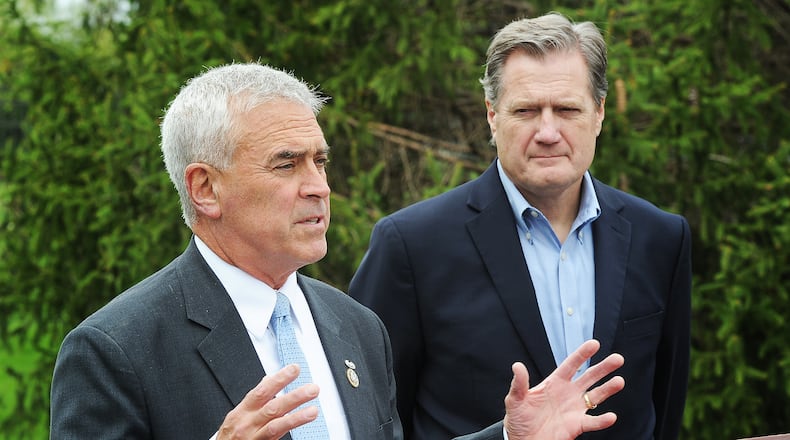“Wright-Patterson Air Force Base and all that is here is a huge component of our critical national security assets, said U.S. Rep. Brad Wenstrup, R-Cincinnati.
“I think they got to see a lot of things firsthand, and that’s always important,” Wenstrup said of the impression the base made on his fellow committee members. “That’s why this committee travels so much. Getting out there and being in the trenches, seeing what’s taking place, guides us.”
U.S. Rep. Mike Turner, R-Dayton, leads that committee as chairman. He is a member of the so-called “Gang of Eight,” a small group of lawmakers enjoying access to some of the most classified data.
“Our conversations concerned, one, how does Wright-Patterson Air Force Base play into our national security, how does it help us in the mission of the Air Force and also the mission of collecting intelligence on our adversaries,” Turner said at a post-retreat media briefing at Wright-Patterson’s Hope Hotel and Conference Center Friday.
Participants also discussed long-term strategies and cooperation between administration principals and the committee.
“This has been a great two days. Everyone has been leaving impressed with Wright-Patterson Air Force Base and the work that’s being done here at NASIC (the National Air and Space Intelligence Center),” Turner said.
Altogether, the base had to accommodate some 50 of the nation’s top intelligence leaders and their staff, triggering a commensurate increase in security and other arrangements.
Wright-Patterson and even Dayton police rose to the occasion, Turner said.
“The base has done an incredible job in hosting us,” he said. “This was an burden, to have 50 people come in and to have the top leadership of the intelligence community right here.”
Wright-Patterson is home to the National Air and Space Intelligence Center (NASIC) and the National Space Intelligence Center (NSIC). Those intelligence-gathering missions feed information to other crucial Air Force missions, such as the Air Force Research Laboratory and the Air Force Materiel Command — also headquartered at Wright-Patterson — positioning them to prepare the nation to deal with emerging threats, as Turner described their roles Thursday.
Intelligence gathered at Wright-Patterson is “translated directly into research at the Air Force Research Lab and then from that, acquisition programs are directed right here at the (Air Force) Life Cycle Management Center,” Turner said. “So to have all three co-located — the intelligence-gathering, the research labs and the acquisitions, right here at one base — it really means it’s a seamless hand-off, so we can protect our country.”
While Turner and Wenstrup could not discuss in detail what was on agenda for the past two days, Turner recently has expressed concerns about the leak of classified material by a 21-year-old member of the Air National Guard in Massachusetts, the ongoing war in Ukraine and a recent classified after-action report on Afghanistan.
“We can only make certain that we don’t repeat those mistakes, if we’re able to really understand them,” the Dayton congressman told the Face the Nation news program Sunday.
About the Author

